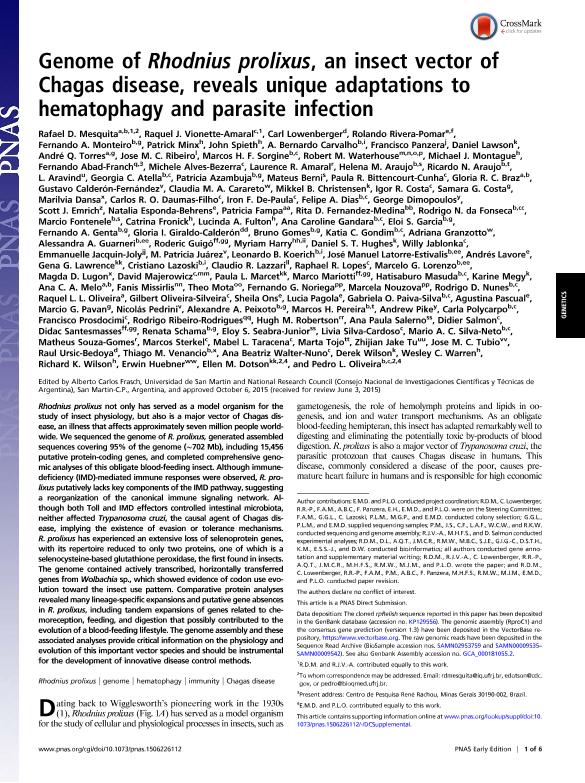Mostrar el registro sencillo del ítem
dc.contributor.author
Calderón Fernández, Gustavo Mario

dc.contributor.author
Esponda Behrens, Natalia Irene

dc.contributor.author
Juarez, Marta Patricia

dc.contributor.author
Latorre Estivalis, Jose Manuel

dc.contributor.author
Lavore, Andres Esteban

dc.contributor.author
Lazzari, Claudio Ricardo

dc.contributor.author
Lorenzo, Marcelo Gustavo

dc.contributor.author
Ons, Sheila

dc.contributor.author
Pagola, Lucia Elena

dc.contributor.author
Pascual, Agustina

dc.contributor.author
Pedrini, Nicolás

dc.contributor.author
Sterkel, Marcos

dc.date.available
2021-10-20T13:34:19Z
dc.date.issued
2015-11-16
dc.identifier.citation
Calderón Fernández, Gustavo Mario; Esponda Behrens, Natalia Irene; Juarez, Marta Patricia; Latorre Estivalis, Jose Manuel; Lavore, Andres Esteban; et al.; Genome of Rhodnius prolixus, an insect vector of Chagas disease, reveals unique adaptations to hematophagy and parasite infection; National Academy of Sciences; Proceedings of the National Academy of Sciences of The United States of America; 112; 48; 16-11-2015; 14936-14941
dc.identifier.issn
0027-8424
dc.identifier.uri
http://hdl.handle.net/11336/144417
dc.description.abstract
Rhodnius prolixus not only has served as a model organism for the study of insect physiology, but also is a major vector of Chagas disease, an illness that affects approximately seven million people worldwide. We sequenced the genome of R. prolixus, generated assembled sequences covering 95% of the genome (?702 Mb), including 15,456 putative protein-coding genes, and completed comprehensive genomic analyses of this obligate blood-feeding insect. Although immunedeficiency (IMD)-mediated immune responses were observed, R. prolixus putatively lacks key components of the IMD pathway, suggesting a reorganization of the canonical immune signaling network. Although both Toll and IMD effectors controlled intestinal microbiota, neither affected Trypanosoma cruzi, the causal agent of Chagas disease, implying the existence of evasion or tolerance mechanisms. R. prolixus has experienced an extensive loss of selenoprotein genes, with its repertoire reduced to only two proteins, one of which is a selenocysteine-based glutathione peroxidase, the first found in insects. The genome contained actively transcribed, horizontally transferred genes from Wolbachia sp., which showed evidence of codon use evolution toward the insect use pattern. Comparative protein analyses revealed many lineage-specific expansions and putative gene absences in R. prolixus, including tandem expansions of genes related to chemoreception, feeding, and digestion that possibly contributed to the evolution of a blood-feeding lifestyle. The genome assembly and these associated analyses provide critical information on the physiology and evolution of this important vector species and should be instrumental for the development of innovative disease control methods.
dc.format
application/pdf
dc.language.iso
eng
dc.publisher
National Academy of Sciences

dc.rights
info:eu-repo/semantics/openAccess
dc.rights.uri
https://creativecommons.org/licenses/by-nc-sa/2.5/ar/
dc.subject
CHAGAS DISEASE
dc.subject
GENOME
dc.subject
HEMATOPHAGY
dc.subject
IMMUNITY
dc.subject
RHODNIUS PROLIXUS
dc.subject.classification
Genética y Herencia

dc.subject.classification
Ciencias Biológicas

dc.subject.classification
CIENCIAS NATURALES Y EXACTAS

dc.title
Genome of Rhodnius prolixus, an insect vector of Chagas disease, reveals unique adaptations to hematophagy and parasite infection
dc.type
info:eu-repo/semantics/article
dc.type
info:ar-repo/semantics/artículo
dc.type
info:eu-repo/semantics/publishedVersion
dc.date.updated
2020-09-08T19:53:26Z
dc.journal.volume
112
dc.journal.number
48
dc.journal.pagination
14936-14941
dc.journal.pais
Estados Unidos

dc.journal.ciudad
Washington DC
dc.description.fil
Fil: Calderón Fernández, Gustavo Mario. Consejo Nacional de Investigaciones Científicas y Técnicas. Centro Científico Tecnológico Conicet - La Plata. Instituto de Investigaciones Bioquímicas de La Plata "Prof. Dr. Rodolfo R. Brenner". Universidad Nacional de la Plata. Facultad de Ciencias Médicas. Instituto de Investigaciones Bioquímicas de La Plata "Prof. Dr. Rodolfo R. Brenner"; Argentina
dc.description.fil
Fil: Esponda Behrens, Natalia Irene. Universidad Nacional de La Plata. Centro Regional de Estudios Genómicos; Argentina. Consejo Nacional de Investigaciones Científicas y Técnicas. Centro Científico Tecnológico Conicet - La Plata; Argentina
dc.description.fil
Fil: Juarez, Marta Patricia. Consejo Nacional de Investigaciones Científicas y Técnicas. Centro Científico Tecnológico Conicet - La Plata. Instituto de Investigaciones Bioquímicas de La Plata "Prof. Dr. Rodolfo R. Brenner". Universidad Nacional de la Plata. Facultad de Ciencias Médicas. Instituto de Investigaciones Bioquímicas de La Plata "Prof. Dr. Rodolfo R. Brenner"; Argentina
dc.description.fil
Fil: Latorre Estivalis, Jose Manuel. Consejo Nacional de Investigaciones Científicas y Técnicas; Argentina. Fundación Oswaldo Cruz; Brasil. Instituto Nacional de Ciencia e Tecnologia en Entomología Molecular; Brasil
dc.description.fil
Fil: Lavore, Andres Esteban. Universidad Nacional de La Plata. Centro Regional de Estudios Genómicos; Argentina. Consejo Nacional de Investigaciones Científicas y Técnicas. Centro Científico Tecnológico Conicet - La Plata; Argentina
dc.description.fil
Fil: Lazzari, Claudio Ricardo. Université François Rabelais; Francia. Consejo Nacional de Investigaciones Científicas y Técnicas; Argentina
dc.description.fil
Fil: Lorenzo, Marcelo Gustavo. Consejo Nacional de Investigaciones Científicas y Técnicas; Argentina. Fundación Oswaldo Cruz; Brasil. Instituto Nacional de Ciencia e Tecnologia en Entomología Molecular; Brasil
dc.description.fil
Fil: Ons, Sheila. Universidad Nacional de La Plata. Centro Regional de Estudios Genómicos; Argentina. Consejo Nacional de Investigaciones Científicas y Técnicas. Centro Científico Tecnológico Conicet - La Plata; Argentina
dc.description.fil
Fil: Pagola, Lucia Elena. Universidad Nacional de La Plata. Centro Regional de Estudios Genómicos; Argentina. Consejo Nacional de Investigaciones Científicas y Técnicas. Centro Científico Tecnológico Conicet - La Plata; Argentina
dc.description.fil
Fil: Pascual, Agustina. Universidad Nacional de La Plata. Centro Regional de Estudios Genómicos; Argentina. Consejo Nacional de Investigaciones Científicas y Técnicas. Centro Científico Tecnológico Conicet - La Plata; Argentina
dc.description.fil
Fil: Pedrini, Nicolás. Consejo Nacional de Investigaciones Científicas y Técnicas. Centro Científico Tecnológico Conicet - La Plata. Instituto de Investigaciones Bioquímicas de La Plata "Prof. Dr. Rodolfo R. Brenner". Universidad Nacional de la Plata. Facultad de Ciencias Médicas. Instituto de Investigaciones Bioquímicas de La Plata "Prof. Dr. Rodolfo R. Brenner"; Argentina
dc.description.fil
Fil: Sterkel, Marcos. Universidade Federal do Rio de Janeiro; Brasil. Universidad Nacional de La Plata. Centro Regional de Estudios Genómicos; Argentina. Consejo Nacional de Investigaciones Científicas y Técnicas. Centro Científico Tecnológico Conicet - La Plata; Argentina
dc.journal.title
Proceedings of the National Academy of Sciences of The United States of America

dc.relation.alternativeid
info:eu-repo/semantics/altIdentifier/doi/http://dx.doi.org/10.1073/pnas.1506226112
dc.relation.alternativeid
info:eu-repo/semantics/altIdentifier/url/https://www.pnas.org/content/112/48/14936.abstract?sid=5d4ef07c-8c85-4343-929d-c696950ee38e
Archivos asociados
